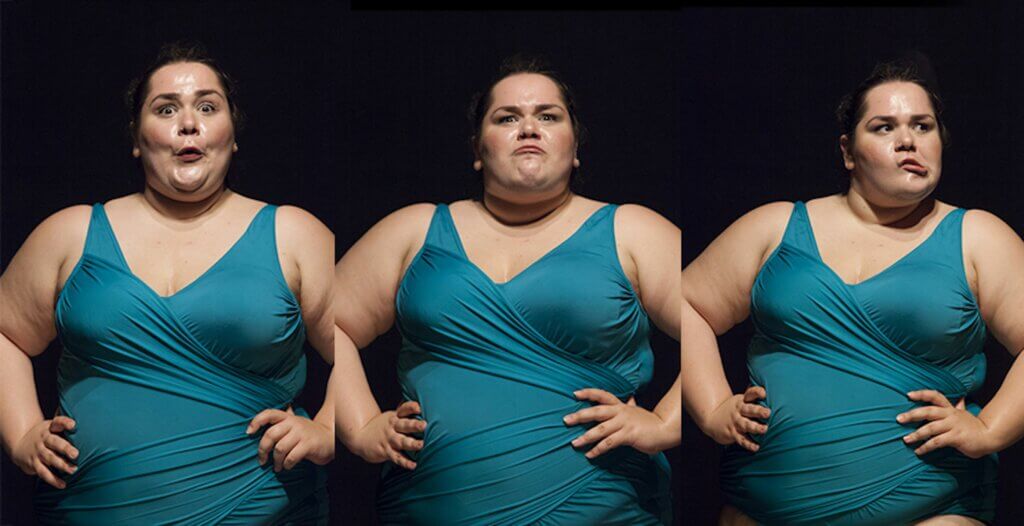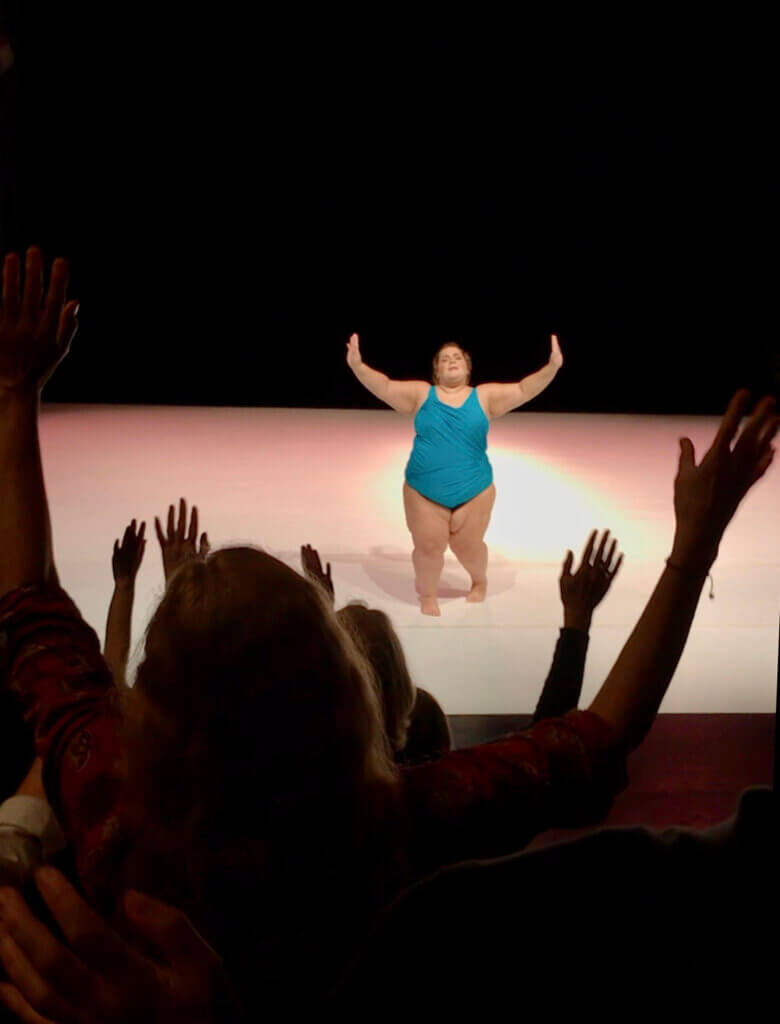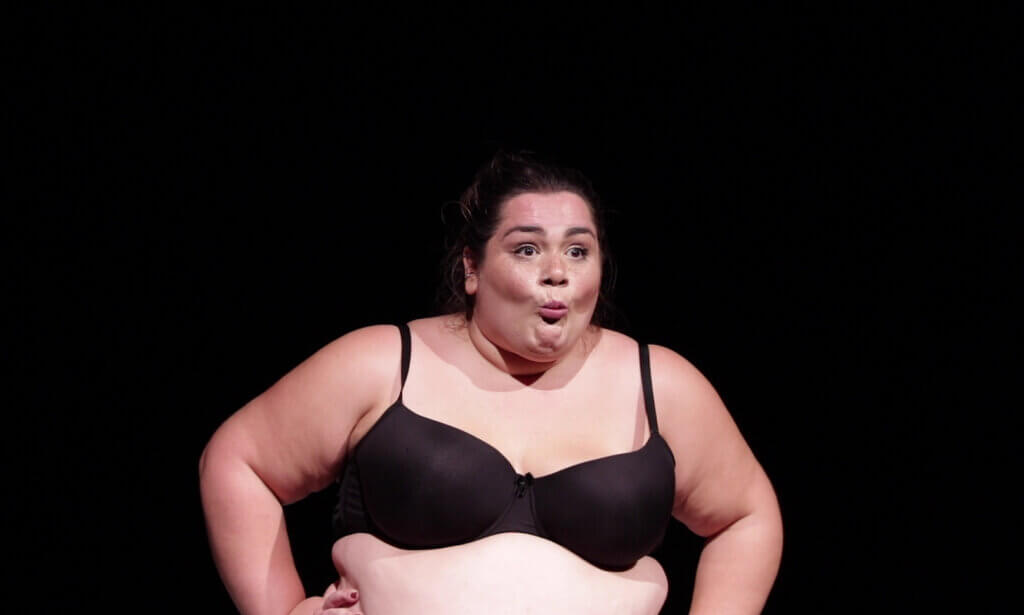R.OSA – 10 Exercises for new Virtuosities af Silvia Gribaudi, Bora Bora
Af Anika Marschall
Bodily Diversity on Stage
We live in times, where morphing your body into a desired look, feel and appearance is normal, if not the norm: from make-up, tattoos, earrings and piercings, to plumped lips and bottoms, six-pack implants, diets and exercising. Despite or exactly because of that, we still deal with a socially constructed binary between normal and not-normal bodies – and the different privileges that come with our bodies, whether they are being forced into some shape or not. The performance R.OSA – 10 Exercises for New Virtuosities by the Italian choreographer Silvia Gribaudi shown at this year’s Move your Mind festival at Bora Bora, plays with audiences’ expectations, by literally shaking up “normalised” and traditional dance theatre-going routines of sitting in the dark and looking onto beautiful or grotesque bodies dancing, moving and labouring on stage. Much like the Italian word “osa” from the performance’s title suggests, Gribaudi “dares” audiences to engage with a “non-normative” dancer body; a body, which is seldomly deemed virtuous, as having agency and bringing about lightness.

In particular, the spectators’ gazes at performer Claudia Marsicano’s fat female body take centre stage themselves. R.OSA is a one-woman show and audience address is key and in two scenes, the performance offers a few “abgespeckt” participatory dance steps for the engaged festival audience. R.OSA fulfills the expectations posed by its title: in a brief 45-minute time span, we watch Marsicano perform ten exercises, displaying how her body can move, sing and dance. In a dramaturgical mix of musical, clown and dance training, she headbangs, fasts forwards her singing, does “the robot”, backbends, shares her three favourite Italian words, makes the audience dance, lipsyncs and waterslides across the stage. Because of Marsicano’s genuinely expressed joy, warm-heartedness and curious wonder about moving in her fat body, as well as her ironic mimicry and cheeky interactions with the audience, the dramaturgy of R.OSA moves spectators gently from insecurity, shame or even disgust for staring at a fat woman, towards ease and pleasure.

The ten exercises Marsicano performs on stage are done against the backdrop of a number of well-known and uplifting melodies and pop songs, including “Jolene” by Dolly Parton and “Toxic” by Britney Spears, as well as classical 18th century French Baroque tunes. The latter links to the interconnectedness between theatre aesthetics and installments of societal norms and hierarchies, when thinking about the norms of propriety and decorum under Ludwig XIV and his passion for ballet. Today, in 2020, the stage lighting puts the pink spotlight on Marsicano, who wears a bright turquoise bathing suit. She announces each exercise, i.e. “Exercise Number 1”, “Exercise Number 2” in a manner of delight. By the time we arrive at the supposedly eighth or ninth movement, Marsicano has even forgotten which number was supposed to follow and comments jokingly that it doesn’t matter anyway. Once again, she knowingly plays with the audience’s expectations of the “exercises” and the rules of the game. This dramaturgical structure reminds of a cabaret or revue show.
Yet the exercises themselves are not always clear cut, they are not sports-related or aerobic for “burning fat”, their purpose and “right way” remains unknown and blurred. Instead, watching Marsicano move is fun and creates a light atmosphere, but there is no clear beginning or ending to a set of movements. It appears as if she improvises and loses herself in each exercise or interrupts herself doing it because it loses its fun and appeal, showing an ironic grin and pulling a sulky face. The exercises are neither excessive in their movements, nor inaccessible or grand enough to take the audience’s or Marsicano’s own breath away. She simply moves. After the fifth or sixth exercise, and after having built a rapport with the audience, she takes off the turquoise suit, and hereby marks a turn in the dramaturgy: while we audiences might have gotten used to watching her fat body in the suit, we are now once again reminded of our own modes of seeing, now that she wears black underwear only and we readjust to stare at new bulges, volumes, layers of fat, skin, tissue and muscles.

Fat Dramaturgy
In between the exercises, Marsicano often repeats a minute-long routine of straightening and tying her hair together into a bun. This repetitive, seemingly innocent act, sits in between the exercise structure of the show. It draws my attention, because it shows the repeated attempt to contain her body – be it the long hair or the fat strings at the seams of the turquoise suit. “No matter the costume, the large female body, its size, is already performance, prior to any staging of it”, as Petra Kuppers has written (“Bodies Out of Bounds”, 2001, p.278). The sheer visuals of fatness and its excess overpower all other signs of a women’s identity. Dance, as in the case of R.OSA, certainly offers some degree of leeway for learning how to gaze tenderly at fat female bodies. The theatre as a transitory space might offer possibilities to learn how to look without hostility, how not to make caricatures out of fat female bodies, and how to forget about any social “givens” about the gender and social reality present in front of us.
Marsicano achieves this through careful gesture and mimicry, which is not excessive at all, but at ease and in charge. Her delivery is very relaxed, almost casual and yet controlled and carefully rehearsed. This is the most important dramaturgical device insofar as fat bodies are predominantly read against a loss of control in contemporary Western cultures: fat bodies are bodies out of control, grotesque, transgressive. Therefore, a crux that R.OSA does not fall into is the problematic, innocent celebration of Marsicano’s fatness. Audiences are not drawn to celebrate her being larger than life, nor do we put her in her place, by reinforcing some cultural stereotypes about the very loud, nasty, fat female entertainer.
Altogether, the director Gribaudi succeeds in employing a Fat Dramaturgy (Jennifer-Scott Mobley 2014, 2019), a dramaturgy which both in its poetics and institutional hierarchies, helps develop a new understanding of fat in performance by disrupting stereotypical narratives. What fat means, how many kilograms it takes to be fat, who we call fat, is culturally constructed. The word “fat” has long been embraced by the Size Acceptance Movement and e.g. fat rights activist Marilyn Wann advocates for its use. There are a number of prominent international fat female performers: Lillian Russell, Marie Dressler, Mae West, Sophie Tucker, Missy Elliot, and Beth Ditto, and there have also been a number of play texts, which deal with fatness and body diversity through social and policital perspectives, including class, race, sex and gender issues: The Good Body by Eve Ensler, Fat Big by Neil LaBute, Fat Blokes by Scottee or Yellowman by Dael Orlandersmith.
These plays and the performance R.OSA certainly speak to ways in which theatre is still a highly oppressive institution when it comes to the production and casting of “non-normative” and fat bodies, as well as storytelling and character development of fat persons. Especially, in dance and physical performance, the pleasure and affects arising when seeing, staring, looking at a diversity of bodies are ever more at stake. Through its staging of gentle gazes and its calm and subtle portrayal of the movements of the fat body, the performance R.OSA utilizes the art form of theatre’s heavy dependence on visuals and a predominant mode of looking at bodies in the flesh. What R.OSA and the theatre as a special place of togetherness can indeed offer is to allow spectators time to stare at and watch a fat female body – and most importantly to make spectators self-reflect on why and how to do this gazing gently, tender and lovingly.
R.OSA spillede på Bora Bora d. 21. og 22. oktober 2020, som en del af Move Your Mind festivalen.
Koncept, koreografi og instruktion: Silvia Gribaudi
Performer: Claudia Marsicano
Lysdesign: Leonardo Benetollo
Kunstneriske konsulenter: Antonio Rinaldi, Giulia Galvan, Francesca Albanese og Matteo Maffesanti
Anika Marschall er Postdoc ved Aarhus Universitet, Institut for Kommunikation og Kultur, Dramaturgi.
